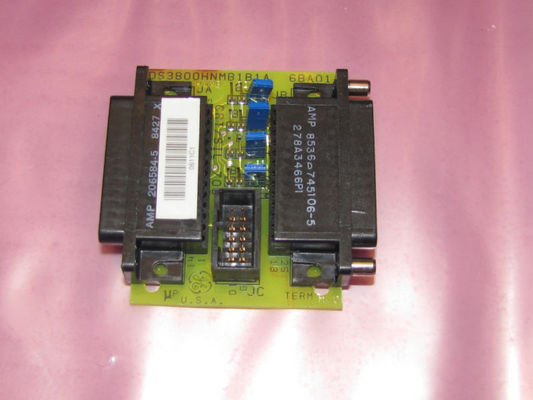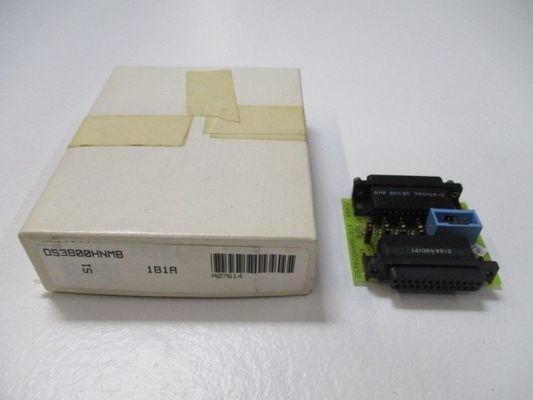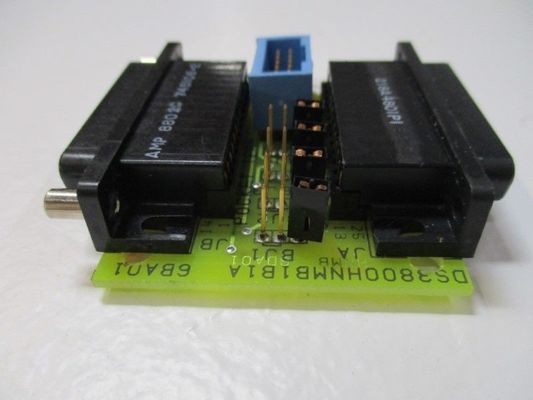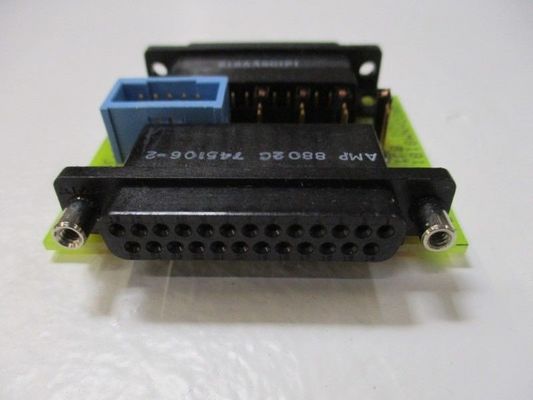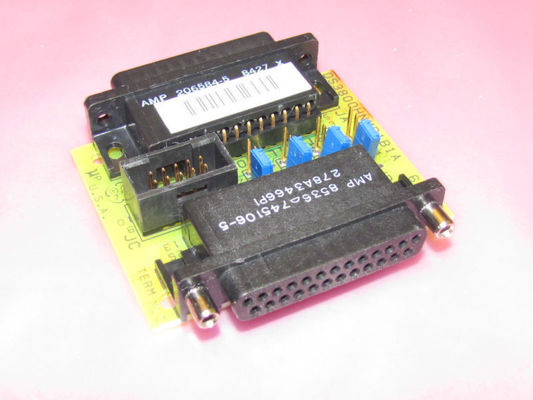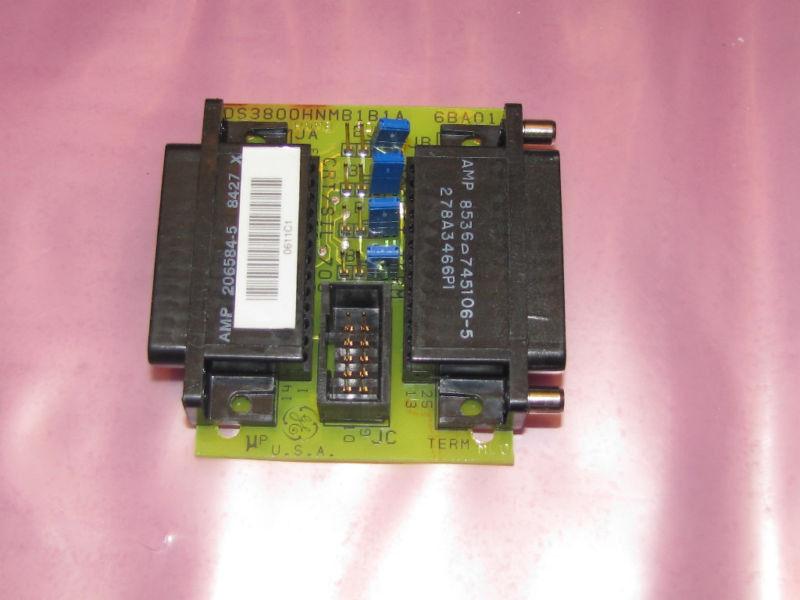Product Description:DS3800HNMB
- Board Layout and Appearance: The DS3800HNMB is a printed circuit board with a specific form factor that is engineered to fit neatly within the framework of the GE Speedtronic Mark IV system. It has a well-organized layout, with components carefully positioned to optimize both functionality and space utilization. The board is typically populated with a variety of electronic components, including integrated circuits, capacitors, resistors, and transistors, all of which work together to perform its intended functions.
On the surface of the board, there are markings and labels that help in identifying different sections, components, and connection points. These markings assist technicians during installation, maintenance, and troubleshooting processes, enabling them to quickly locate specific elements or understand the board's internal circuitry.
- Connector Types and Placement: It features several types of connectors that are strategically placed to allow for easy integration with other components in the gas turbine control system. There are likely connectors for receiving and sending electrical signals related to various aspects of turbine operation, such as sensor inputs and actuator outputs. These connectors may include pin headers, socket connectors, or specialized connectors designed to interface with specific cables or other boards within the system. The design of the connectors ensures reliable electrical connections, minimizing the risk of signal loss or interference.
- Communication Functionality: At its core, the DS3800HNMB serves as a media access unit, facilitating communication within the gas turbine control system. It acts as a null modem communication card, which means it enables direct communication between two devices without the need for a traditional modem or additional communication equipment. It supports specific communication protocols that are integral to the Mark IV system, allowing different components like controllers, sensors, and actuators to exchange data effectively.
This communication capability is essential for coordinating the operation of the gas turbine. For example, it enables the transfer of critical information from temperature sensors located in the turbine's combustion chamber to the control unit, which then uses this data to make decisions regarding fuel injection and combustion optimization. Similarly, it allows control commands to be sent from the control unit to actuators that adjust components such as fuel valves or air intake mechanisms, ensuring the turbine operates at the desired performance levels.
- Signal Processing: The board is equipped to handle and process a wide range of signals related to the gas turbine's operation. It can receive analog signals from various sensors throughout the turbine, such as those measuring temperature, pressure, vibration, and electrical parameters like phase currents and differential currents. For instance, it can process signals related to the phase current's fundamental frequency components (I1 and I2), the fundamental frequency component of the differential current (Id1f), the fundamental frequency component of the stable current (Ib1f), as well as the second and fifth harmonic components of the differential current (Id2f and Idf5 respectively).
These signals undergo various processing steps, which may include amplification, filtering (such as digital filtering to remove noise and isolate specific frequency components), analog-to-digital conversion, and other forms of signal conditioning. This processed data is then used for further analysis within the control system, enabling precise monitoring and control of the gas turbine's performance and condition.
- Control and Coordination: Based on the signals it processes and the communication it facilitates, the DS3800HNMB plays a vital role in the overall control and coordination of the gas turbine. It helps in implementing the control logic that determines how the turbine responds to different operating conditions. For example, if the processed sensor signals indicate that the turbine's temperature is rising above a safe threshold, the board can assist in transmitting the appropriate commands to the relevant actuators to adjust the fuel flow or cooling mechanisms, thereby maintaining the turbine's temperature within the acceptable range.
It also contributes to the synchronization and coordination of different subsystems within the gas turbine. In a complex turbine setup with multiple components working in tandem, such as the combustion system, the rotor assembly, and the auxiliary systems, the DS3800HNMB ensures that these components operate in harmony by facilitating the exchange of necessary information and control signals.
- Power Generation: In the context of power generation, particularly in gas turbine power plants using the GE Speedtronic Mark IV control system, the DS3800HNMB is an indispensable component. It enables seamless communication between the numerous sensors monitoring the turbine's performance (e.g., temperature sensors in the hot sections, pressure sensors in the fuel and air supply lines, and vibration sensors on the rotating parts) and the control algorithms that determine the optimal operation of the turbine. This allows for efficient power generation by ensuring that the turbine operates at its highest efficiency while maintaining safety and reliability.
For example, during startup, shutdown, and load changes, the board helps in coordinating the precise adjustments to fuel injection, air flow, and other parameters based on real-time sensor feedback. It also enables remote monitoring and control of the gas turbine, allowing operators in a central control room to oversee multiple turbines and make adjustments as needed to meet power grid demands or respond to any operational issues.
- Industrial Automation Integration: Beyond its direct role in gas turbine control, the DS3800HNMB can also contribute to the integration of the gas turbine's operation with broader industrial automation systems. In industrial plants where gas turbines are part of a combined heat and power (CHP) setup or are used to drive other processes (such as compressors in a manufacturing facility), the board can communicate with other control systems like programmable logic controllers (PLCs), distributed control systems (DCS), or building management systems (BMS).
This integration allows for a more comprehensive and coordinated approach to managing energy usage and industrial processes. For instance, in a chemical plant with a gas turbine providing power and steam for different production processes, the DS3800HNMB can share data with the plant's DCS to ensure that the turbine's output is adjusted in line with the power and heat requirements of the various chemical reactions and equipment in operation.
-
Temperature and Humidity Tolerance: The DS3800HNMB is engineered to operate within specific environmental conditions. It can typically function reliably in a temperature range that is common in industrial settings, usually from -20°C to +60°C. This wide temperature tolerance allows it to be deployed in various locations, from cold outdoor environments like those in power generation sites during winter to hot and humid indoor manufacturing areas or equipment rooms. Regarding humidity, it can handle a relative humidity range typical of industrial areas, typically within the non-condensing range (around 5% to 95%), ensuring that moisture in the air does not cause electrical short circuits or damage to the internal components.
-
Electromagnetic Compatibility (EMC): To operate effectively in electrically noisy industrial environments where there are numerous motors, generators, and other electrical equipment generating electromagnetic fields, the DS3800HNMB has good electromagnetic compatibility properties. It is designed to withstand external electromagnetic interference and also minimize its own electromagnetic emissions to prevent interference with other components in the system. This is achieved through careful circuit design, the use of components with good EMC characteristics, and proper shielding where necessary, allowing the board to maintain signal integrity and reliable communication in the presence of electromagnetic disturbances.
Features:DS3800HNMB
- Null Modem Communication: As a null modem communication card, the DS3800HNMB enables direct device-to-device communication without the need for a traditional modem. This is highly advantageous in the context of the gas turbine control system as it simplifies the communication setup and allows for quick and efficient data exchange between different components within the system. For example, it can facilitate seamless communication between controllers, sensors, and actuators located in close proximity within the turbine's control cabinet or in nearby enclosures, ensuring real-time data sharing and coordination of operations.
- Protocol Support: It is designed to support specific communication protocols relevant to the Mark IV system. These protocols are tailored to handle the unique requirements of gas turbine control, including the transmission of critical sensor data (such as temperature, pressure, and vibration readings) and the conveyance of control commands for actuators. By adhering to these standardized protocols, the board ensures reliable and accurate communication, minimizing the risk of errors or data loss during transmission. This enables the different parts of the turbine control system to work together in harmony and make informed decisions based on the received information.
- High-Speed Data Transfer: The DS3800HNMB is capable of facilitating high-speed data transfer, which is crucial for quickly relaying information between various components of the gas turbine control system. In a complex turbine environment where numerous sensors are constantly generating data and control commands need to be sent promptly to actuators, this high-speed transfer capability ensures that the system can respond rapidly to changes in operating conditions. For instance, it can quickly transmit updated temperature sensor readings from the combustion chamber to the control unit, allowing for immediate adjustments to fuel injection or cooling parameters to maintain optimal turbine performance.
-
- Analog and Digital Signal Handling: The board can proficiently handle both analog and digital signals. It has the ability to receive a wide variety of analog signals from sensors positioned throughout the gas turbine, including those measuring temperature (with voltage signals proportional to temperature), pressure (generating voltage or current signals related to pressure levels), and vibration (providing signals based on vibration amplitudes). For these analog signals, the DS3800HNMB can perform essential processing tasks such as amplification to boost weak sensor signals, filtering to remove electrical noise and interference, and analog-to-digital conversion to convert the analog signals into a digital format suitable for further processing and analysis within the control system.
-
Simultaneously, it can manage digital signals from various sources like switches, digital sensors, and status indicators. It ensures proper logic level conversion and signal integrity for seamless integration with other digital components in the control system. This dual capability makes it a versatile component for interfacing with the diverse array of sensors and actuators commonly found in gas turbine control systems.
- Specialized Signal Filtering: One of the standout features in signal processing is its ability to perform specialized filtering on specific electrical parameters related to the gas turbine's operation. For example, it can apply digital filtering techniques to isolate and analyze the fundamental frequency components of phase currents (I1 and I2), the fundamental frequency component of the differential current (Id1f), the fundamental frequency component of the stable current (Ib1f), as well as the second and fifth harmonic components of the differential current (Id2f and Idf5 respectively). This detailed signal analysis helps in accurately diagnosing the health of the electrical systems within the turbine, detecting potential faults or abnormal conditions related to current imbalances or electrical disturbances, and providing valuable information for preventive maintenance and precise control of the turbine's operation.
-
- LED Indicator Lights: The DS3800HNMB is equipped with multiple LED indicator lights that serve as valuable visual cues for technicians and operators. These lights can provide immediate information about different aspects of the board's operation and the status of the communication and signal processing functions. For instance, there might be LEDs to indicate power-on status, active communication links, the presence of errors or warnings (such as a communication error or a signal out of range), or the status of specific functions or circuits within the board. By simply looking at these lights, personnel can quickly assess the health of the board and identify potential issues without having to rely on complex diagnostic tools immediately.
- Test Points (TPs): The presence of numerous test points on the board is another significant feature. These test points allow technicians to access specific points in the circuit using test equipment like multimeters or oscilloscopes. They can measure electrical parameters such as voltage, current, or signal waveforms at these points to diagnose problems, verify signal integrity, or understand the behavior of the board's internal circuitry. For example, if a particular sensor signal is suspected to be faulty, technicians can use the test points near the input of that signal to check its characteristics and determine if there is an issue with the sensor, the signal conditioning, or another part of the circuit.
-
- Jumpers for Configuration: The board has several jumpers that offer a convenient way to configure various aspects of its functionality. By changing the positions of these jumpers, users can customize settings such as enabling or disabling certain features, selecting between different operating modes, or adjusting parameters related to communication or signal processing. For example, a jumper might be used to switch between different baud rates for serial communication if the board supports multiple communication speeds, or to choose whether to use a particular input signal for a specific control function. This flexibility allows for easy adaptation of the board to different application requirements and system setups.
- Adaptability to Different Applications: Thanks to its combination of configurable features and its ability to handle various types of signals and communicate with different components, the DS3800HNMB can be adapted to a wide range of applications within the gas turbine control and broader industrial systems. Whether it's for a gas turbine with specific combustion control requirements, integration with other industrial processes in a combined heat and power (CHP) setup, or adaptation to different power generation scenarios, the board can be customized to fit the specific context.
-
- Compact and Sturdy Design: The physical design of the DS3800HNMB is optimized to be both compact and sturdy. Its form factor is designed to fit within the specific space constraints of the GE Speedtronic Mark IV system while being able to withstand the mechanical stress and vibrations that are common in industrial environments. The components on the board are securely mounted, and the overall layout is designed to minimize the risk of damage from physical impacts or vibrations that might occur during normal operation of the gas turbine or other industrial equipment.
- Easy Installation and Alignment: The board is likely labeled with markings such as board ID, alphanumeric codes, and arrows that assist in the installation process. These markings provide clear guidance for cabling, positioning, and alignment within the control cabinet or enclosure. This makes it easier for technicians to install the board correctly and connect it to other components in the system, reducing the likelihood of installation errors that could lead to operational issues.
-
- Wide Temperature Range: The DS3800HNMB is engineered to operate within a relatively wide temperature range, typically from -20°C to +60°C. This broad temperature tolerance enables it to function reliably in various industrial environments, from cold outdoor locations like those in power generation sites during winter to hot manufacturing areas or equipment rooms where it may be exposed to heat generated by nearby machinery. This ensures that the board can maintain its performance and communication capabilities regardless of the ambient temperature conditions.
- Humidity and Electromagnetic Compatibility (EMC): It can handle a wide range of humidity levels within the non-condensing range common in industrial settings, usually around 5% to 95%. This humidity tolerance prevents moisture in the air from causing electrical short circuits or corrosion of the internal components. Moreover, the board has good electromagnetic compatibility properties, meaning it can withstand external electromagnetic interference from other electrical equipment in the vicinity and also minimize its own electromagnetic emissions to avoid interfering with other components in the system. This allows it to operate stably in electrically noisy environments where there are numerous motors, generators, and other electrical devices generating electromagnetic fields.
Technical Parameters:DS3800HNMB
-
Power Supply
- Input Voltage: The board typically operates within a specific range of input voltages. Commonly, it accepts a DC voltage input, and the typical range is around +12V to +30V DC. However, the exact voltage range can vary depending on the specific model and application requirements. This voltage range is designed to be compatible with the power supply systems commonly found in industrial settings where the gas turbine control systems are deployed.
- Power Consumption: Under normal operating conditions, the power consumption of the DS3800HNMB usually falls within a certain range. It might consume approximately 5 to 15 watts on average. This value can vary based on factors such as the level of communication activity, the number of signals being processed, and the complexity of the functions it's performing.
-
Input Signals
- Digital Inputs
- Number of Channels: There are typically several digital input channels available, often in the range of 8 to 16 channels. These channels are designed to receive digital signals from various sources like switches, digital sensors, or status indicators within the gas turbine control system.
- Input Logic Levels: The digital input channels are configured to accept standard logic levels, often following TTL (Transistor-Transistor Logic) or CMOS (Complementary Metal-Oxide-Semiconductor) standards. A digital high level could be in the range of 2.4V to 5V, and a digital low level from 0V to 0.8V.
- Analog Inputs
- Number of Channels: It generally has multiple analog input channels, usually ranging from 4 to 8 channels. These channels are used to receive analog signals from sensors such as temperature sensors, pressure sensors, and vibration sensors.
- Input Signal Range: The analog input channels can handle voltage signals within specific ranges. For example, they might be able to accept voltage signals from 0 - 5V DC, 0 - 10V DC, or other custom ranges depending on the configuration and the types of sensors connected. Some models may also support current input signals, typically in the range of 0 - 20 mA or 4 - 20 mA.
- Resolution: The resolution of these analog inputs is usually in the range of 10 to 16 bits. A higher resolution allows for more precise measurement and differentiation of the input signal levels, enabling accurate representation of sensor data for further processing within the control system.
-
Output Signals
- Digital Outputs
- Number of Channels: There are typically several digital output channels, often in the range of 8 to 16 channels as well. These channels can provide binary signals to control components like relays, solenoid valves, or digital displays within the gas turbine control system.
- Output Logic Levels: The digital output channels can provide signals with logic levels similar to the digital inputs, with a digital high level in the appropriate voltage range for driving external devices and a digital low level within the standard low voltage range.
- Analog Outputs
- Number of Channels: It may feature a number of analog output channels, usually ranging from 2 to 4 channels. These can generate analog control signals for actuators or other devices that rely on analog input for operation, such as fuel injection valves or air intake vanes.
- Output Signal Range: The analog output channels can generate voltage signals within specific ranges similar to the inputs, such as 0 - 5V DC or 0 - 10V DC. The output impedance of these channels is usually designed to match typical load requirements in industrial control systems, ensuring stable and accurate signal delivery to the connected devices.
-
Processor
- Type and Clock Speed: The board incorporates a microprocessor with a specific architecture and clock speed. The clock speed is typically in the range of tens to hundreds of MHz, depending on the model. This determines how quickly the microprocessor can execute instructions and process the incoming signals. For example, a higher clock speed allows for faster data analysis and decision-making when handling multiple input signals simultaneously.
- Processing Capabilities: The microprocessor is capable of performing various arithmetic, logical, and control operations. It can execute complex control algorithms based on the programmed logic to process the input signals from sensors and generate appropriate output signals for actuators or for communication with other components in the system.
-
Memory
- EPROM (Erasable Programmable Read-Only Memory) or Flash Memory: The DS3800HNMB contains memory modules, which are usually either EPROM or Flash memory, with a combined storage capacity that typically ranges from several kilobytes to a few megabytes. This memory is used to store firmware, configuration parameters, and other critical data that the board needs to operate and maintain its functionality over time. The ability to erase and reprogram the memory allows for customization of the board's behavior and adaptation to different industrial processes and changing requirements.
- Random Access Memory (RAM): There is also a certain amount of onboard RAM for temporary data storage during operation. The RAM capacity might range from a few kilobytes to tens of megabytes, depending on the design. It is used by the microprocessor to store and manipulate data such as sensor readings, intermediate calculation results, and communication buffers as it processes information and executes tasks.
-
Serial Interfaces
- Baud Rates: The board supports a range of baud rates for its serial communication interfaces, which are commonly used for connecting to external devices over longer distances or for interfacing with legacy equipment. It can typically handle baud rates from 9600 bits per second (bps) up to higher values like 115200 bps or even more, depending on the specific configuration and the requirements of the connected devices.
- Protocols: It is compatible with various serial communication protocols such as RS232, RS485, or other industry-standard protocols depending on the application needs. RS232 is often used for short-distance, point-to-point communication with devices like local operator interfaces or diagnostic tools. RS485, on the other hand, enables multi-drop communication and can support multiple devices connected on the same bus, making it suitable for distributed industrial control setups where several components need to communicate with each other and with the DS3800HNMB.
-
Parallel Interfaces
- Data Transfer Width: The parallel interfaces on the board have a specific data transfer width, which could be, for example, 8 bits, 16 bits, or another suitable configuration. This determines the amount of data that can be transferred simultaneously in a single clock cycle between the DS3800HNMB and other connected components, typically other boards within the same control system. A wider data transfer width allows for faster data transfer rates when large amounts of information need to be exchanged quickly, such as in high-speed data acquisition or control signal distribution scenarios.
- Clock Speed: The parallel interfaces operate at a certain clock speed, which defines how frequently data can be transferred. This clock speed is usually in the MHz range and is optimized for efficient and reliable data transfer within the control system.
- Operating Temperature: The DS3800HNMB is designed to operate within a specific temperature range, typically from -20°C to +60°C. This temperature tolerance allows it to function reliably in various industrial environments, from relatively cold outdoor locations to hot manufacturing areas or power plants where it may be exposed to heat generated by nearby equipment.
- Humidity: It can operate in environments with a relative humidity range of around 5% to 95% (non-condensing). This humidity tolerance ensures that moisture in the air does not cause electrical short circuits or corrosion of the internal components, enabling it to work in areas with different levels of moisture present due to industrial processes or environmental conditions.
- Electromagnetic Compatibility (EMC): The board meets relevant EMC standards to ensure its proper functioning in the presence of electromagnetic interference from other industrial equipment and to minimize its own electromagnetic emissions that could affect nearby devices. It is designed to withstand electromagnetic fields generated by motors, transformers, and other electrical components commonly found in industrial environments and maintain signal integrity and communication reliability.
- Board Size: The physical dimensions of the DS3800HNMB are usually in line with standard industrial control board sizes. It might have a length in the range of 8 - 16 inches, a width of 6 - 12 inches, and a thickness of 1 - 3 inches, depending on the specific design and form factor. These dimensions are chosen to fit into standard industrial control cabinets or enclosures and to allow for proper installation and connection with other components.
- Mounting Method: It is designed to be mounted securely within its designated housing or enclosure. It typically features mounting holes or slots along its edges to enable attachment to the mounting rails or brackets in the cabinet. The mounting mechanism is designed to withstand the vibrations and mechanical stress that are common in industrial environments, ensuring that the board remains firmly in place during operation and maintaining stable electrical connections.
Applications:DS3800HNMB
- Process Drive Applications: In industrial manufacturing settings where gas turbines are used to drive mechanical processes, such as in factories that use gas turbines to power large compressors for air supply or pumps for fluid transfer, the DS3800HNMB is vital for ensuring that the turbine operates in a manner that meets the specific requirements of the driven equipment. It facilitates the communication between the turbine control system and the sensors and actuators on the driven machinery. For example, in a chemical plant where a gas turbine drives a centrifugal compressor for gas compression, the board receives signals related to the pressure and flow requirements of the gas being compressed and relays this information to the turbine control system. The control system then adjusts the turbine's power output and speed accordingly to maintain the desired compression ratio and flow rate.
- Process Integration and Coordination: The DS3800HNMB also helps in integrating the operation of the gas turbine with the overall industrial process. It can communicate with other control systems in the manufacturing facility, such as programmable logic controllers (PLCs) or distributed control systems (DCS), to share information about the turbine's status, performance, and any potential issues. This enables seamless coordination between different parts of the manufacturing process and allows for more efficient production. For instance, in an automotive manufacturing plant where a gas turbine provides power for various production lines, the board can send data to the central control system about the turbine's availability and power output. The central control system can then use this information to optimize the allocation of resources and schedule maintenance activities without disrupting production.
- Energy Optimization: In CHP systems installed in commercial buildings, hospitals, or industrial campuses, the DS3800HNMB is used to manage the operation of the gas turbine to simultaneously produce electricity and useful heat. It coordinates the communication between the turbine control system and the systems responsible for utilizing the heat, such as heating, ventilation, and air conditioning (HVAC) systems, hot water boilers, or industrial process heat exchangers. For example, in a hospital with a CHP system, the board can adjust the turbine's output to ensure that there is sufficient electricity for critical medical equipment while also providing hot water or steam for heating and sterilization purposes. It monitors the power and heat demands of the facility and makes the necessary adjustments to optimize the overall energy utilization and reduce reliance on external energy sources.
- System Integration: The DS3800HNMB enables integration of the gas turbine-based CHP system with the building's energy management system (EMS). It provides data on the turbine's performance, energy output, and efficiency to the EMS, which can then use this information for overall energy optimization strategies. For instance, the EMS can use the data from the DS3800HNMB to make decisions about when to prioritize electricity generation for on-site use versus exporting excess power to the grid, depending on factors like electricity prices, building occupancy, and heating/cooling needs.
- Gas Turbine and Renewable Energy Interaction: In hybrid power systems that combine gas turbines with renewable energy sources like wind or solar power, the DS3800HNMB plays a role in coordinating the operation of the different energy sources. It can communicate with the control systems of the renewable energy components and the grid to manage power flows and ensure stable and efficient operation. For example, when wind power generation is high and exceeds the grid's immediate demand, the board can adjust the gas turbine's operation to reduce its power output or even shut it down temporarily, while also facilitating the storage or distribution of excess energy. Conversely, during periods of low renewable energy availability, it can ramp up the gas turbine's power production to meet the power requirements.
- Energy Storage Integration: In systems where energy storage is incorporated, such as batteries or flywheels, the DS3800HNMB can interface with the energy storage control systems. It can receive signals related to the state of charge of the energy storage, grid demand, and turbine performance to make decisions on when to store or release energy and how to adjust the turbine's operation to support the grid. For instance, during off-peak hours when electricity prices are low, the board can direct the gas turbine to charge the energy storage system while maintaining a minimum power output to the grid. Then, during peak demand periods, it can use the stored energy to boost the overall power supply and optimize the combined operation of the gas turbine and energy storage.
Customization:DS3800HNMB
-
- Control Algorithm Customization: Depending on the unique characteristics of the gas turbine application and the industrial process it's integrated into, the firmware of the DS3800HNMB can be customized to implement specialized control algorithms. For example, in a gas turbine used for fast-response peaking power generation with rapid load changes, custom algorithms can be developed to optimize the response time for adjusting fuel flow and air intake. These algorithms can take into account factors like the turbine's specific performance curves, the expected frequency of load variations, and the desired power output ramp rates. In a gas turbine operating in a combined heat and power (CHP) system where heat output needs to be prioritized based on the specific heating requirements of a building or industrial process, the firmware can be programmed to adjust the turbine's operation accordingly, perhaps sacrificing some electrical power output to maintain a stable heat supply.
- Fault Detection and Handling Customization: The firmware can be configured to detect and respond to specific faults in a customized manner. Different gas turbine models or operating environments may have distinct failure modes or components that are more prone to issues. In a gas turbine located in a dusty environment, for instance, the firmware can be programmed to closely monitor air filter pressure drop and trigger alerts or automatic corrective actions if the pressure drop exceeds a certain threshold, indicating potential clogging that could affect combustion efficiency. In a gas turbine with a history of bearing temperature issues, the firmware can be customized to implement more sensitive temperature monitoring and immediate shutdown or load reduction protocols when abnormal temperature increases are detected.
- Communication Protocol Customization: To integrate with existing industrial control systems that may use different communication protocols, the DS3800HNMB's firmware can be updated to support additional or specialized protocols. If a power plant has legacy equipment that communicates via an older serial protocol like RS232 with specific custom settings, the firmware can be modified to enable seamless data exchange with those systems. In a modern setup aiming for integration with cloud-based monitoring platforms or Industry 4.0 technologies, the firmware can be enhanced to work with protocols like MQTT (Message Queuing Telemetry Transport) or OPC UA (OPC Unified Architecture) for efficient remote monitoring, data analytics, and control from external systems.
- Data Processing and Analytics Customization: The firmware can be customized to perform specific data processing and analytics tasks relevant to the application. In a gas turbine within a hybrid power system combining renewable energy sources, the firmware can be programmed to analyze the interaction between the gas turbine and the renewables. It can calculate metrics such as the proportion of power generated by the gas turbine compared to the total power output of the system and how efficiently the turbine is operating in conjunction with the other energy sources. This data can then be used to optimize the overall system operation and make decisions about when to ramp up or down the gas turbine's output. In a CHP system, the firmware can analyze the power and heat demands of the facility over time and adjust the turbine's operation to optimize the balance between electricity generation and heat production.
- Enclosure and Protection Customization:
- Harsh Environment Adaptation: In industrial environments that are particularly harsh, such as those with high levels of dust, humidity, extreme temperatures, or chemical exposure, the physical enclosure of the DS3800HNMB can be customized. Special coatings, gaskets, and seals can be added to enhance protection against corrosion, dust ingress, and moisture. For example, in a desert-based power plant where dust storms are common, the enclosure can be designed with enhanced dust-proof features and air filters to keep the internal components of the board clean. In a chemical processing plant where there is a risk of chemical splashes and fumes, the enclosure can be made from materials resistant to chemical corrosion and sealed to prevent any harmful substances from reaching the internal components of the control board.
- Thermal Management Customization: Depending on the ambient temperature conditions of the industrial setting, custom thermal management solutions can be incorporated. In a facility located in a hot climate where the control board might be exposed to high temperatures for extended periods, additional heat sinks, cooling fans, or even liquid cooling systems (if applicable) can be integrated into the enclosure to maintain the device within its optimal operating temperature range. In a cold climate power plant, heating elements or insulation can be added to ensure the DS3800HNMB starts up and operates reliably even in freezing temperatures.
- Compliance Customization:
- Nuclear Power Plant Requirements: In nuclear power plants, which have extremely strict safety and regulatory standards, the DS3800HNMB can be customized to meet these specific demands. This might involve using materials and components that are radiation-hardened, undergoing specialized testing and certification processes to ensure reliability under nuclear conditions, and implementing redundant or fail-safe features to comply with the high safety requirements of the industry. In a nuclear-powered naval vessel or a nuclear power generation facility, for example, the control board would need to meet stringent safety and performance standards to ensure the safe operation of the systems that rely on the DS3800HNMB for input signal processing and control in gas turbine or other relevant applications.
- Aerospace and Aviation Standards: In aerospace applications, there are specific regulations regarding vibration tolerance, electromagnetic compatibility (EMC), and reliability due to the critical nature of aircraft operations. The DS3800HNMB can be customized to meet these requirements. For example, it might need to be modified to have enhanced vibration isolation features and better protection against electromagnetic interference to ensure reliable operation during flight. In an aircraft auxiliary power unit (APU) that uses a gas turbine for power generation and requires input signal processing for its control systems, the board would need to comply with strict aviation standards for quality and performance to ensure the safety and efficiency of the APU and associated systems.
Support and Services:DS3800HNMB
Our technical support and services team is dedicated to providing you with the best possible assistance for your Other product.
We offer:
- 24/7 phone support
- Email support
- Live chat support
- Online technical documentation and resources
- Product training and onboarding
- Repair and maintenance services
Our knowledgeable and experienced team is committed to ensuring your satisfaction and helping you get the most out of your Other product.

 Your message must be between 20-3,000 characters!
Your message must be between 20-3,000 characters! Please check your E-mail!
Please check your E-mail!  Your message must be between 20-3,000 characters!
Your message must be between 20-3,000 characters! Please check your E-mail!
Please check your E-mail! 
